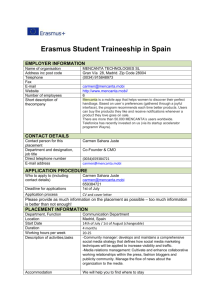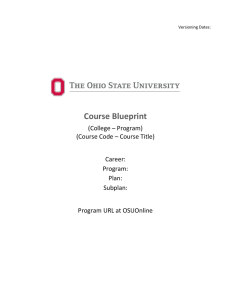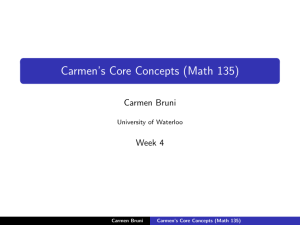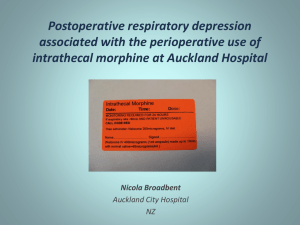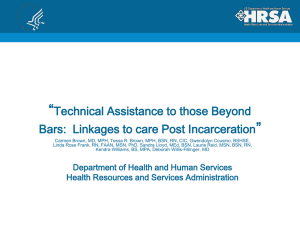3 - LWW.com
advertisement
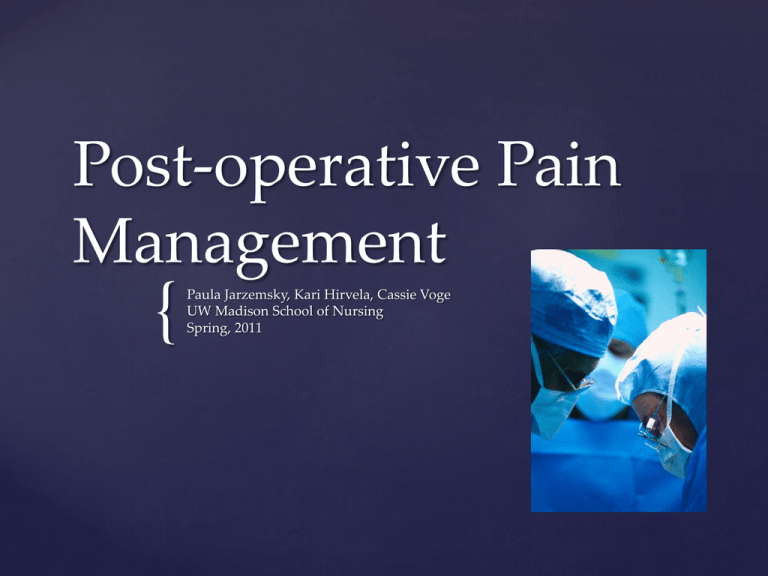
Post-operative Pain
Management
{
Paula Jarzemsky, Kari Hirvela, Cassie Voge
UW Madison School of Nursing
Spring, 2011
Disclaimer
All names and characters in the following slides are fictional.
The protocols, patient education forms, etc. are current as of May,
2011.
{
Please see reference list near the end of the module for due credit to
prior authors’ works which made this module possible.
To hear audio clips, be in Slide Show mode and have your volume at
an appropriate level.
QSEN Competencies
In this module you will learn more about:
Informatics: navigate an Electronic Health Record (EHR); use highquality information sources
Patient-centered care: provide compassionate, coordinated care based
on respect for patient preferences, values and needs
Evidenced-based practice: locate a relevant clinical practice
guideline; discriminate when to modify EBP based on clinical
expertise or patient preferences
The place . . .
The University of Wisconsin-Madison (UW) Hospital & Clinics
Meet Carmen . . .
Shift to Shift Hand Off Note
Jen Smith, RN (day shift) gave verbal report to Chris, RN (PM shift)
regarding the care of Carmen Gonzales using the standardized SBAR
report.
Carmen is a 56-year-old female with a history of CAD, CHF, HTN, type
2 diabetes mellitus. She was admitted through the emergency
department on Sunday with osteomyelitis and gangrene of her leg
and underwent wound debridement today (Monday). She returned to
the surgical unit an hour ago.
AVSS
Oxygen: RA
Pain: stable though 6/10, 2 mg IV morphine with relief
Vascular access device sites intact
Other tubes/lines
Dressing CDI (clean, dry, intact)
And you are . . .
Chris, RN. You completed a nurse residency program at UW Hospital and
now carry your own patient assignment without direct supervision of a
preceptor. Today, you will take care of Carmen after her surgery.
Click the icon below to hear the verbal handoff/SBAR (shift-to-shift) report
from the AM shift nurse . . .
Decision #1 (gather information)
After hearing shift report, you decide to:
Check the
EHR
(Electronic
Health
Record)
Talk to a
colleague
All the nurses on
your unit are really
busy right now, so
this is not an option
right now. What
would you like to talk
about anyway?
See the patient
Continue
scenario . . .
Check the EHR . . .
Flow Sheets
Physician’s
Orders
After viewing all 3,
click here to go
back to ‘decision
#1’
MAR
(Medication
Administration
Record)
Flow Sheets
1500 VS:
Back to EHR
Sedation
Score
1
MD Orders
Back to EHR
MAR
Back EHR
See the patient . . .
Initial observation of Carmen: Carmen is sitting up in bed, eyes
closed and moaning quietly. Dressing clean, dry, and intact over L
lower leg. Pulses 2+ bilateral. L foot is warm, with + movement
and sensation. When asked about pain, Carmen begins to cry,
reporting 8/10 pain at the surgical site.
Click audio clip:
Back to
‘decision #1’
What next?
You need to make a decision based on this information – with the
current order, you cannot administer any more pain medication
(Jen Smith, day shift RN last administered 2 mg of IV morphine at 2:30pm).
You decide to call for an order
change:
Click the below icons (in order) to listen to conversation:
Chris, RN
Dr. Sakei
Chris, RN
Dr. Sakei
Decision #2
Now that a range order is available (2-6 mg Morphine IV every 2 hours
PRN), you need to decide how much to give within this range. Keep in
mind it is 3:30 pm and Carmen received 2 mg of IV morphine at 2:30 pm.
1 mg
2 mg
3 mg
6 mg
1 mg
Try again.
This is less than the desired dose.
Back to Q#2
2 mg
Try again.
This is less than the desired dose.
Back to Q#2
3 mg
Correct!
If pain goal is not achieved, try 50%
greater than the previous dose
Link to Pain
Management
Reference
Continue scenario . . .
6 mg
Try again.
This is higher than the desired dose and
may cause negative side effects (nausea,
sedation, respiratory depression)
Click to view an evidence-based protocol:
Respiratory
Depression
& Narcan
Decision #3
At 1600, you return to reevaluate Carmen’s pain. She describes
her pain as moderately better, but still reports a pain rating of
6/10 . She drifts off to sleep once during the conversation, but is
arousable. Respirations are shallow and regular, at a rate of
14/min. She denies any nausea.
As you think about your assessment of Carmen ,you decide to:
Give more IV
morphine, as
her pain
rating is 6/10.
Give no
morphine and
call Dr. Sakei
to alert him of
your
assessment.
Give no
morphine, as
she describes
her pain as
‘moderately
better’ and
continue to
monitor
Carmen
Give more morphine
Try again.
Administering more morphine may bring
Carmen’s pain rating below a ‘6’, but she is
already experiencing side effects (sedation).
Remember to look at the “big picture” and
not just the pain rating: Carmen verbalized
‘moderate pain relief’.
Back to Q#3
Call the MD
Try again.
The MD will likely ask you to continue monitoring
the patient – something you would do anyway.
Back to Q#3
Monitor, no morphine
Best choice!
Carmen seems groggy, so your best option is to
hold off on giving any more morphine for
now.
Reassessment after giving a pain med is key:
Carmen described her pain as “better”, even
though she rated it as “6/10”.
Continue
scenario . . .
Decision #4
It is 1645. You respond to Carmen’s call light and she has a pain rating
of 8/10. What dose should you give and why:
0 mg:
2 mg:
3 mg:
Tell Carmen
she needs to
wait until
1730 for her
next dose.
This dose
provided
minimal side
effects.
This dose
provided best
pain relief
with
manageable
side effects.
Try again.
A pain rating
of 8/10 needs
intervention.
Try again.
This dose was
ineffective
previously.
Best choice,
nice job!
Decision #5
The next morning, Jose (Carmen's husband) comes to visit. Last night,
Carmen experienced good pain relief and no side effects (other than
yesterday’s transient sedation that you monitored well!). Jose does not like
that she is taking IV pain medication. Carmen asks what other options she
has. At this time, it is most appropriate for you to explain that:
“Postop pain
is best
managed with
IV meds.
Let’s stay with
what works.”
“I can reduce
the dosage –
let’s try 1 mg the
next time you
need
medication.”
“If Carmen feels
ready to
transition to
other pain relief
measures, let’s
discuss options
with the team.”
“If there are
alternatives to pain
medication that
have worked for
you in the past, let’s
talk about them.”
Try again. This
is not the most
patientcentered
response.
Try again. While
this is a more
collaborative
approach, it
may not achieve
effective
analgesia.
Good choice,
nice job!
Good choice,
well-done!
There is
another good
choice . . .
There is
another good
choice . . .
Key Points
Always assess your patient
Know how to access your facility’s pain algorithm and resources.
Consider cultural perspectives and involve the patient and family
as much as possible in clinical decisions.
Understand the importance of integrating EB guidelines (pain
algorithm, etc.) into your practice.
Click on the icons for other resources related to this scenario:
Pain
Algorithm
(UWHC)
Pain
Management
Reference
(UWHC)
Cultural
Aspects of
Pain
Management
(UWHC)
Click ‘page
down’ to
view
references.
References
Gordon, D. & Pellino, T. (2005). Incidence and characteristics of Naloxone use in postoperative pain management.
Pain Management Nursing 6 (1), pp. 30-36.
Gordon, D.B., Dahl, J., Phillips, P., Frandsen, J., Cowley, C., Foster, R.L., Fine, P.G., Miaskowski, C., Fishman, S., &
Finley, R.S. (2004). The use of “as-needed” range orders for opioid analgesics in the management of acute pain: A
consensus statement of the American Society for Pain Management Nursing and the American Pain Society. Pain
Management Nursing, 5(2), 53-58.
Pasero, C., Manwarren, R. & McCaffrey, M. (2007). IV opioid range orders for acute pain management. American
Journal of Nursing 107 (2), 52-60.
Pasero,C., Portenoy, R.K., & McCaffery, M. (1999). Opioid analgesics. In M. McCaffery & Pasero (Eds.), Pain: clinical
manual 2nd ed (pp. 161-299). St. Lous: Mosby.
Cultural Aspects of Pain Fast Fact - http://www.eperc.mcw.edu/fastFact/ff_78.htm and University of Wisconsin
Hospital and Clinics (Madison, WI)
Respiratory Depression from Opioids Fast Fact – University of Wisconsin Hospital and Clinics (Madison, WI)
Pain Algorithm – University of Wisconsin Hospital and Clinics (Madison, WI), adapted from Memorial SloanKettering (New York, NY)
Pain Management Reference – University of Wisconsin Hospital and Clinics (Madison, WI)
Sedation Assessment Scale - University of Wisconsin Hospital and Clinics (Madison, WI)
Images of Carmen, EHR, MAR modified and used with permission from Elsevier SLS system.
All other images & audio clips from ClipArt within PowerPoint software application
You have completed the Post-Operative Pain Management Module.
EB Pain Algorithm
Back to
Key
Points
Pain Management Reference
(UWHC 2011)
Click here to continue to
Question #3
Back to
Key
Points
Cultural Aspects of Pain
Back to
Key
Points
Respiratory Depression
Back to Q#2

